1934 Buffalo Nickel Coin Value: How Much Is It Worth?
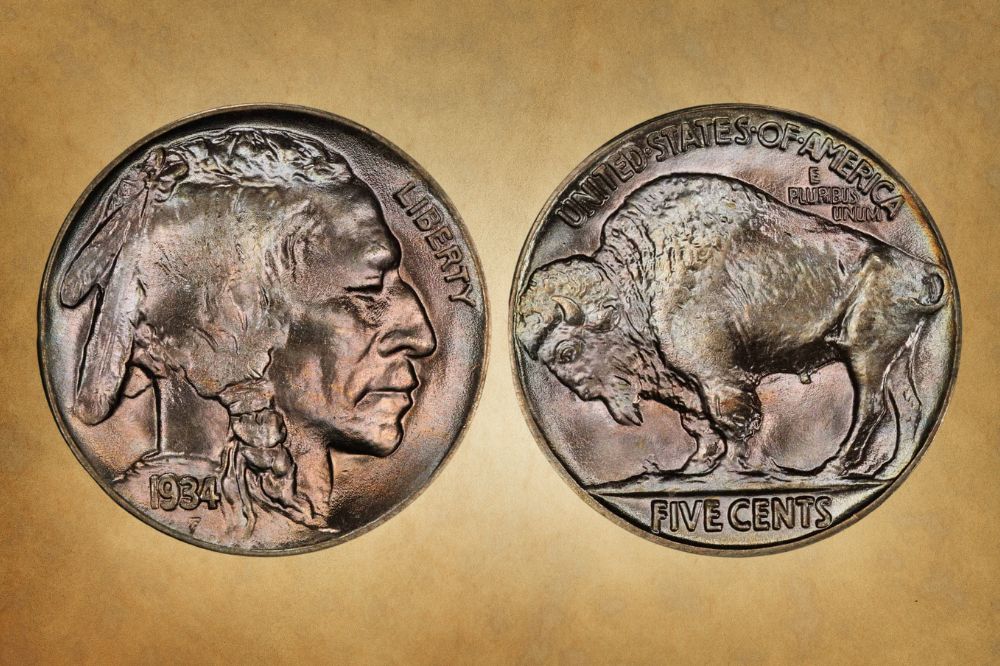
Like many things that don’t end well, the Buffalo Nickel began with the best of intentions. For some, it’s one of the prettiest US coins ever made. To others, it’s a personal affront and a logistical nightmare. Also … that’s not a buffalo! Let’s assess the 1934 Buffalo Nickel Value.
1934 Nickel Value Chart |
|||||
| Mint Mark | Good (G 4) | Fine (F 12) | Extremely Fine (EF 40) | Uncirculated (MS 60) | Mint State (MS 63) |
| 1934 (P) No Mint Mark Buffalo Nickel Value | $1.42 | $2.81 | $11 | $55 | $74 |
| 1934-D Buffalo Nickel Value | $1.71 | $4.52 | $23 | $91 | $140 |
1934 Buffalo Nickel Value Guide
In 1932, Buffalo Nickels were only made in Philadelphia and Denver. And because the design of these coins didn’t change much during its 25-year run, it’s not always easy to confirm the mint date. On most of these coins, the date was the first thing to fade because that’s where fingers settled in circulation. So having a visible date and mint mark already raises the price.
1934 (P) No Mint Mark Buffalo Nickel Value
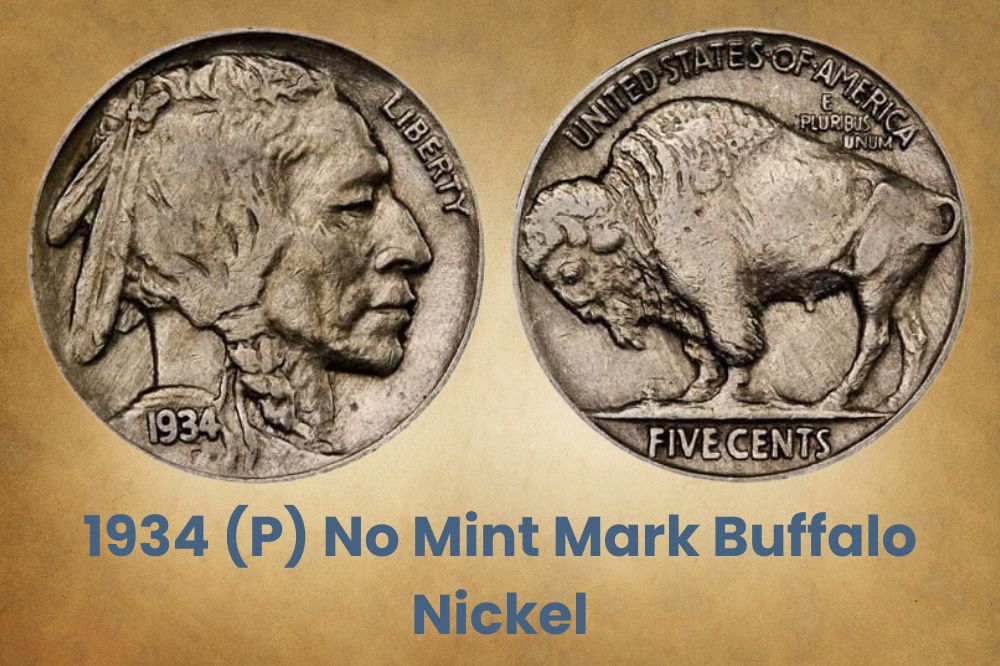
In 1934, the Philadelphia Mint made 20,213,003 Buffalo Nickels without mint marks. In MS 67, this coin once sold for more than $8,500. In AU 58, the resale price goes down to $90.
1934-D Buffalo Nickel Value
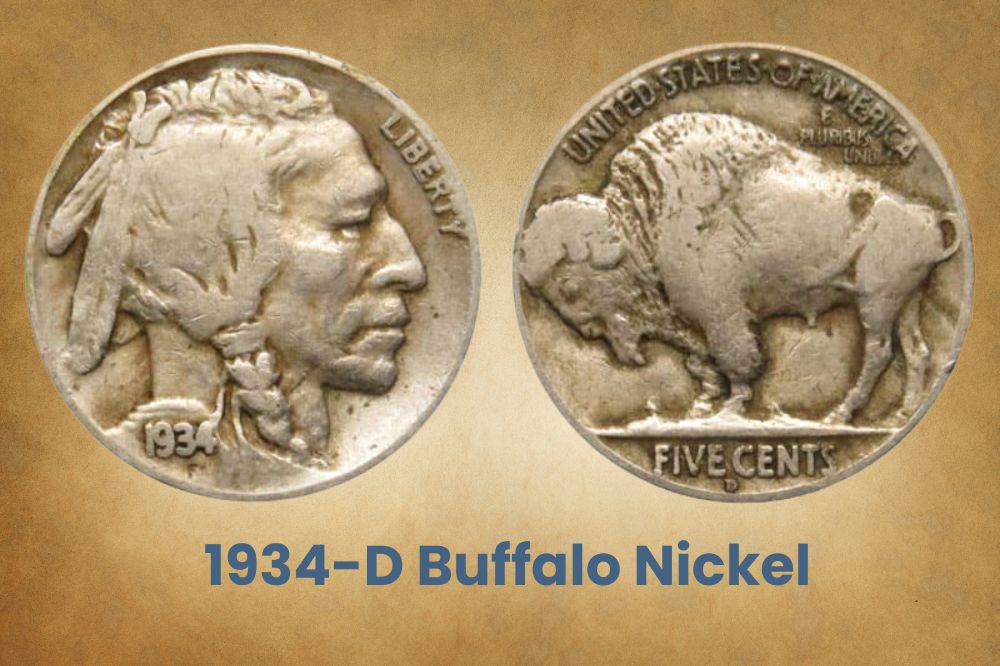
1934 saw 7,480,000 Buffalo Nickels coined at the Denver Mint. An AU 58 is only worth $50 but in MS 66+, a 1934-D Buffalo Nickel once sold for over $11,000! Also, keep in mind the 1934-D Buffalo Nickel was minted in Large D and Small D varieties, based on the size of the mint mark. But it doesn’t change prices much, and an AU 53 Small D was only worth $30.
Related Posts: 17 Most Valuable Nickel Errors
1934 Buffalo Nickel Errors
To understand how coin errors happen, it helps to know how coins are made. The artist sketches several designs and once one is approved, the mint uses a reducing machine to craft a prototype through stages that involve plaster, rubber, and epoxy. The final Galvano is formed into a steel master hub, which makes a master die, a working hub, and working dies.
These working dies will strike planchets to make coins, and each stage – hubbing, die-ing, and minting – involves multiple strikes. If the target metal moved between strikes, you can get doubling, tripling, or even quadrupling errors like DDOs, TDRs, or off-centers, and each error has a distinct value that it adds to the coin. So let’s look at the prices of various flaws.
1934 (P) Buffalo Nickel Struck 10% Off-Centre
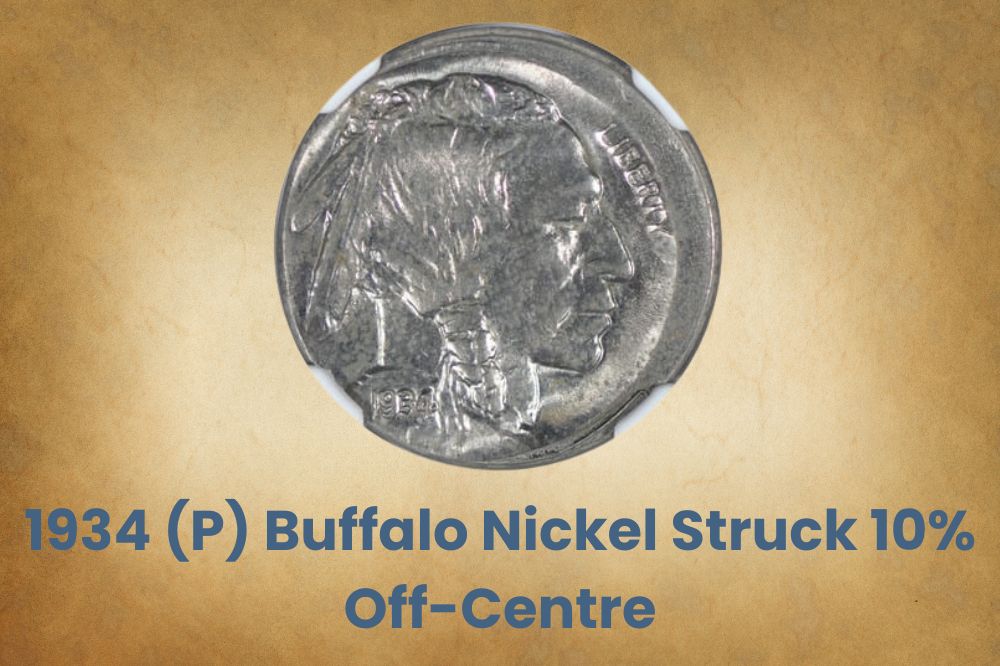
The Buffalo Nickel is already a closely cropped coin, with the device almost touching the collar on both the front and the back. So if the coin is struck off-center, the visual effect can be rather drastic. This 10% off-center error left a subtle blank sliver at the top front and bottom back of the coin, and in MS 64, the coin sold for more than $580 due to its mint state.
1934 (P) Buffalo Nickel Struck on a Penny Planchet
On the previous off-center error, part of the legend on the back got sliced off. And something similar can happen if the coin is mistakenly struck on a smaller denomination. In this case, the 21.21mm nickel was struck on a 19.05mm 1c planchet, so a bit of the words and date are sliced off. Also, it’s a penny planchet so it’s copper-colored. In MS 62 BN, it’s worth $4,600.
1934-D Buffalo Nickel Reverse Struck Thru Error
On occasion, a foreign object will slip between the die and the planchet, leaving its silhouette on the coin. This 1934-D experienced interference on the reverse that left distinct dimpling on the bison’s rump. It’s a tricky error because this coin is highly textured, so you’d need a keen eye – and/or a coin microscope! In MS 63, this strike thru error is worth roughly $215.
Related Posts: 19 Most Valuable Nickel Worth Money
History of the 1934 Buffalo Nickel
If you look at early American coins, you may be unimpressed. They typically featured a symbolic image of Lady Liberty in low relief and were rather two-dimensional. Turns out this was intentional, because coins with high relief, intense texture, and tons of detail were harder to mint – and more expensive too! So the Mint always erred on the side of simplicity.
This changed in 1904 when Theodore Roosevelt, the 35th US President, demanded that the mint start making prettier coins with more artistic merit. He brought in external artists to ensure this was done properly, starting with his friend Augustus Saint-Gaudens. But when Saint-Gaudens died of cancer before completing his commission, his assistants continued.
They included Avigdor ben Gershon aka Victor David Brenner, who designed the Lincoln Cent, and James Earle Fraser, who worked on the Buffalo Nickel. All three artists clashed with the Chief Mint Engraver, Charles E. Barber. Barber had taken over the job when his father died, and he had personally designed the previous Liberty Cap motif (1892 to 1916).
His design was used on dimes, quarters, half dollars, and the obverse of the nickel. And Roosevelt’s mandate called for the redesign of all these coins, so in Barber’s words, he felt was ‘… being asked to systematically undo his entire life’s work!’ To make matters worse, these commercial coin sculptors were more interested in texture, beauty, and fine detail.
As a result, their coins were busy and bumpy, with endless design elements and multiple points of high relief. This meant they needed extra strikes to render them correctly, wore out the dies much faster, and therefore cost the mint a lot more to make! Also, these artists had to sign their work and often wanted larger fonts and signatures than mint engravers. Yikes!
Still, ever the civil servant, Barber assuaged his concerns through stubborn bureaucracy. On multiple occasions, he subtly redesigned the new coins to make them easier and cheaper to mint. This included lowering relief levels, repositioning elements, and in the case of the Lincoln Penny, removing the designer’s initials! But let’s get back to the Buffalo Nickel.
The Story of the Buffalo Nickel
We’ve mentioned the issue of high relief (i.e. dramatically raised portions on the coin) and why mint engravers disliked them. But many commercial artists favored this technique, and Roosevelt specifically requested it because he thought it made Ancient Greek coins pretty. So when Fraser designed the Buffalo Nickel, he included lots of high relief for extra aesthetics.
The reverse had it on the bison’s horn, tail, legs, and the hill it stood on. The obverse had it on the cheekbones and clothing. Sadly, these high-relief sections were the first to wear down, and that’s why lots of existing Buffalo Nickels have no date, denomination, or maker’s mark. The high relief made the dies wear out up to three times faster, which was a large extra expense.
To try and resolve this, Barber adjusted the design. Initially, the bison stood on a hill, but Barber changed that to flatter ground. He also thickened the font on the denomination and the date. Weirdly, these tweaks made the dies wear out even faster! Another barrier to this pretty coin came from the Hobbs Manufacturing Company which made counterfeit detectors.
The company’s owner, Clarence Hobbs, believed these new coins would stymie his machines so he asked for a long list of changes. Hobbs and Fraser went back and forth for almost six months until Fraser complained to the Secretary of the Treasury, Franklin MacVeagh. The Secretary then presided over a legal-style hearing involving the two men and their lawyers.
In the end, MacVeagh ruled the coins could be minted as they were, with no further changes. The public loved the beauty of these coins, but experts warned that they would soon wear out, which they did. Also, the mint resented the extra expense of replacing dies. So while the coins proved popular, the mint was glad to replace them as soon as they could legally do so.
So after 25 years, in 1938, the Buffalo Nickel was joyfully replaced by the Jefferson Nickel, which was a lot less controversial. This new design proved so popular that it’s still in use today. The new Jefferson Nickel coin was designed by Felix Oscar Schlag and has only been redesigned once to celebrate the Bicentennial of the Westward Journey of Lewis and Clark.
Related Posts: 20 Most Valuable Buffalo Nickels Worth Money
How to Identify the 1934 Buffalo Nickel?
We’ve already mentioned that the buffalo on this nickel is a bison, but it’s time for a little more housekeeping. Let’s go over the top technical terms in the coin space. Coins are made from blank metal sheets called planchets that get punched into round discs of the right size.
The front or heads side of a coin is called the obverse while the back or tails side is known as the reverse. On a coin, the images are called devices, the background is called a field, and the words are called mottos or legends. The coin designer gets to put his/her initials on the coin.
(Laura Gardin Fraser is the only female coin designer acknowledged so far, though her 1931 design wasn’t used until 1999 and 2002! Yes, she is related to James Earle Fraser. She was his student, and later his wife!) And yes, obverses and reverses can have different designers.
The Obverse of the 1934 Buffalo Nickel
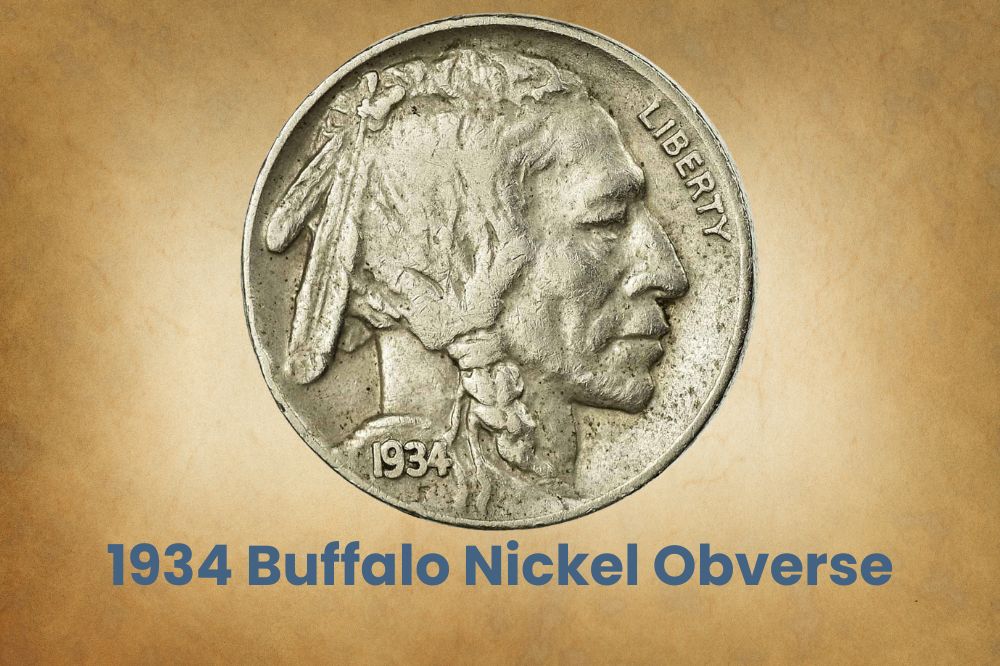
The obverse (heads side) of the 1934 Buffalo Nickel features a Native American Chief with traditional feathers in his hair. His profile faces right, with the legend Liberty in front of his nose and the mint date at the base of his neck. The designer’s initial (F) sits under the date.
The Reverse of the 1934 Buffalo Nickel
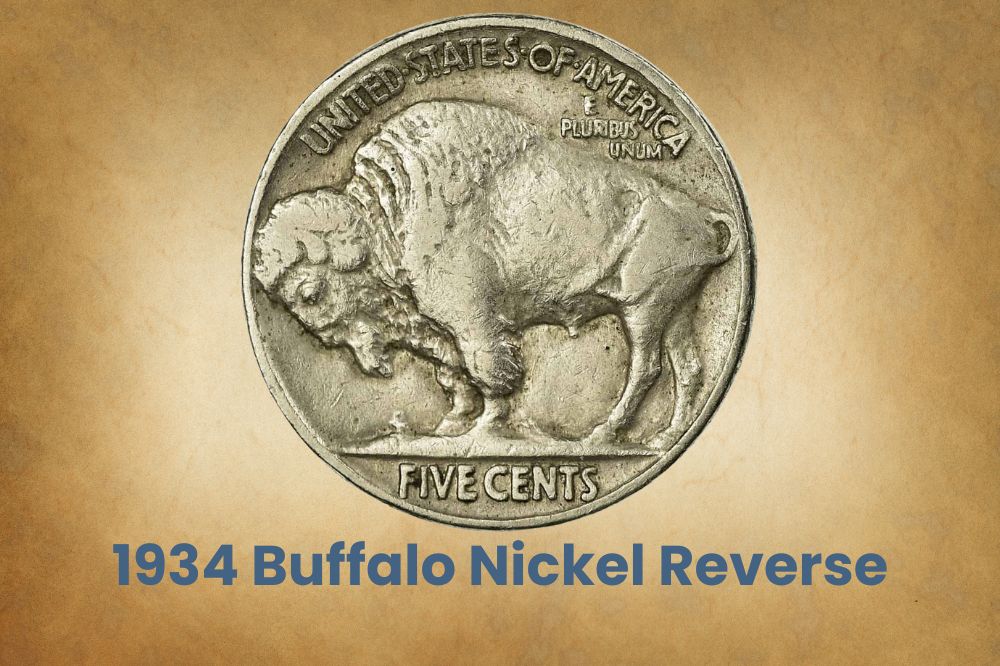
The reverse (tails side) of the 1934 Buffalo Nickel features an American Bison standing on a patch of earth. The top of the coin reads United States of America, with E Pluribus Unum tucked above its back. The bottom of the coin reads Five Cents with the mint mark below it.
Other Features of the 1934 Buffalo Nickel
The 1934 Buffalo Nickel gets its name from bison on the reverse, though some people do refer to it as the Indian Head – or more recently, the Native American Head Nickel. It’s 21.21mm in diameter and 1.95mm thick. In 1934, it was made of 75% copper and 25% nickel.
The nickel content is what gave 5-cent coins their nickname. No Buffalo Nickels were made in 1932 and 1933, so 1934 invited a lot of interest. And while no Proof Buffalo Nickels were minted – ever – it wasn’t personal, since nickel proofs didn’t exist between 1879 and 1970.
FAQs About the 1934 Buffalo Nickel
Is a 1934 Buffalo Nickel Rare?
No, the 1934 Buffalo Nickel is quite easy to find and lots of samples exist. But like other Buffalo Nickels, many of the features of the coin were in high relief and they quickly wore down in circulation. So while you can find endless 1934 Buffalo Nickels in low grades, it’s tougher to find them in uncirculated condition, and they’re even rarer in high mint states.
How Do I Know if My Buffalo Nickel is Valuable?
Check the date, denomination, and mint mark. Because so few coins exist with these details still visible, they instantly add value to the coin. And if the coin is from a key date, even better! These include 1913-S, 1916/16, 1918/17-D, 1921-S, 1924-S, 1926-S, and the 3-leg or 3 ½ leg varieties from 1935 and 1937. Generally speaking though, Buffalo Nickels with dates are more valuable than those without. But never use chemicals to restore the date since that diminishes the value of the coin. And yes, coin experts can tell when you’ve pulled this move!
What Year Buffalo Nickel is Worth the Most?
Flawless samples of the 1926-S Buffalo Nickel have sold for over $300,000. But that’s for a high-grade coin with no mint errors. If you’re more interested in error coins, look for the 3-leg or 3 ½ leg varieties of 1935 and 1937. These routinely sell for thousands of dollars.
